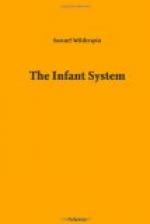The next may contain raw cotton, cotton yarn, sewing cotton, unbleached calico, bleached calico, dimity, jean, fustian, velveteen, gause, nankeen, gingham, bed furniture, printed calico, marseilles, flannel, baise, stuff; woollen cloth and wool, worsted, white, black, and mixed.
The next may contain milled board, paste board, Bristol card, brown paper, white paper of various sorts, white sheep skin, yellow sheep, tanned sheep, purple sheep, glazed sheep, red sheep, calf skin, cow hide, goat skin, kid, seal, pig leather, seal skin, wash leather, beaver, &c.
The next may contain about twenty-five of those wood animals which are imported into this country, and are to be had at the foreign toy warehouses; some of them are carved exceedingly well, and appear very like the real animals.
The next may contain mahogany, and the various kinds of wood.
The next may contain prunings of the various fruit trees, all about an inch long, or an inch square.
The next may contain the different small articles of ironmongery, needles, pins, cutlery, small tools, and every other object that can be obtained small enough for the purpose.
The lessons are to be put in the lesson-post the same as the picture lessons; and the articles are either glued, or fastened on the boards with screws or waxed thread.
I would have dried leaves provided, such as an oak leaf, an elm leaf, an ash leaf, &c. &c. The leaves of ever-greens should be kept separate. These will enable a judicious instructor to communicate a great variety of valuable information.
On some things connected with such instruction I find I arrived at the same conclusions as Pestalozzi, though I have never read his works, and for some years after my first efforts, did not know that such a person existed. I mean, however, to give my views on teaching by objects more fully in a work I hope soon to prepare, to be entitled “The Infant Teacher in the Nursery and the School.”
The utility of this mode of teaching must be obvious, for if the children meet with any of those terms in a book which they are reading, they understand them immediately, which would not be the case unless they had seen the object. The most intellectual person would not be able to call things by their proper names, much less describe them, unless he had been taught, or heard some other person call them by their right names; and we generally learn more by mixing with society, than ever we could do at school: these sorts of lessons persons can make themselves, and they will last for many years, and help to lay a foundation for things of more importance.
I am convinced the day is not far distant when a museum will be considered necessary to be attached to every first rate school for the instruction of children.




